From May 6-14, 2011, we will be undertaking a field project off the island of Hawai‘i, our second field effort in Hawai‘i this year and the 10th year in a row we’ve worked off the island of Hawai‘i. This project is funded through a sub-award from Scripps Institution of Oceanography (from a grant from the Office of Naval Research), with the primary goal of recording acoustic data from short-finned pilot whales and other odontocetes using suction-cup attached acoustic tags. As usual though we are working with all species of odontocetes encountered, adding to our photo-ID catalogs, collecting prey samples, and hoping to deploy satellite-dive tags on several species.
End of field project update
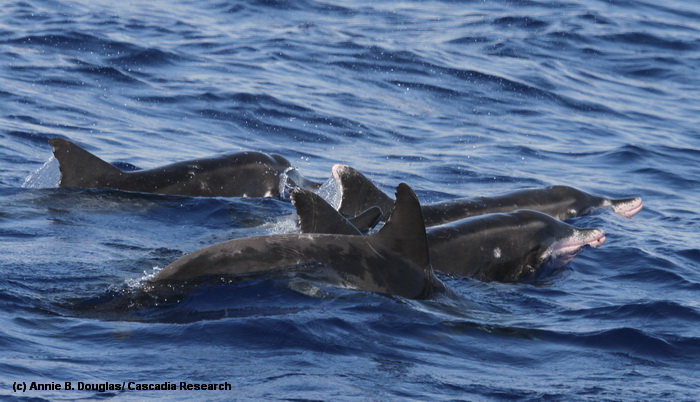
Rough-toothed dolphins, May 14, 2011. Photo by Annie Douglas
Our last full day on the water was Saturday, and we encountered another large group of rough-toothed dolphins. Although this time the encounter was in fairly rough sea conditions and the group was not as cooperative, we were able to photo-identify a number of the individuals present. Over the 9 day duration of this field project we covered 1,253 kilometers and encountered 22 groups of 7 species of odontocetes. As well as the two acoustic tags we deployed and recovered, we took ~86 GB of photos which will be incorporated into our photo-ID catalogs, and also obtained 7 genetic samples of four different species. Overall a very productive trip. We are looking forward to our next field project in Hawai‘i, starting in late July off the island of Kaua‘i.
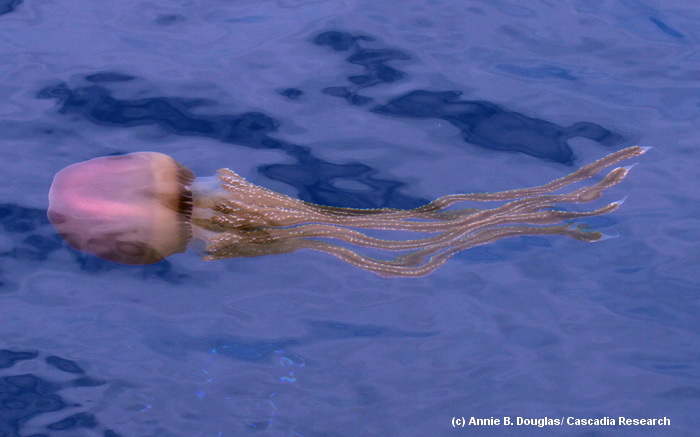
Jellyfish, May 14, 2011. Photo by Annie Douglas
May 13, 2011 update
A good day on the water, we encountered four species of odontocetes (including two new species for the trip), and were able to recover the suction-cup attached acoustic tag deployed on a spotted dolphin two days ago.
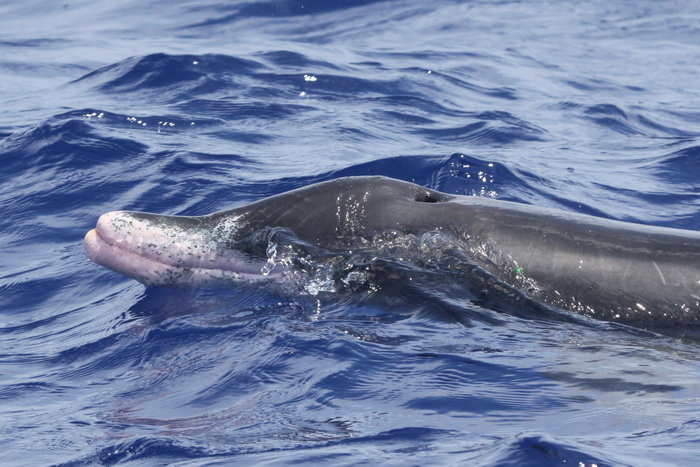
The white rostrum of an older rough-toothed dolphin, May 13, 2011. Photo by Jessica Aschettino. The rostrum of rough-toothed dolphins appears to become whiter with age.
Today we encountered a group of over 40 rough-toothed dolphins, and were able to obtain photographs to individually identify almost every individual present, as well as collect three biopsy samples for genetic studies being undertaken by Renee Albertson of Oregon State University.
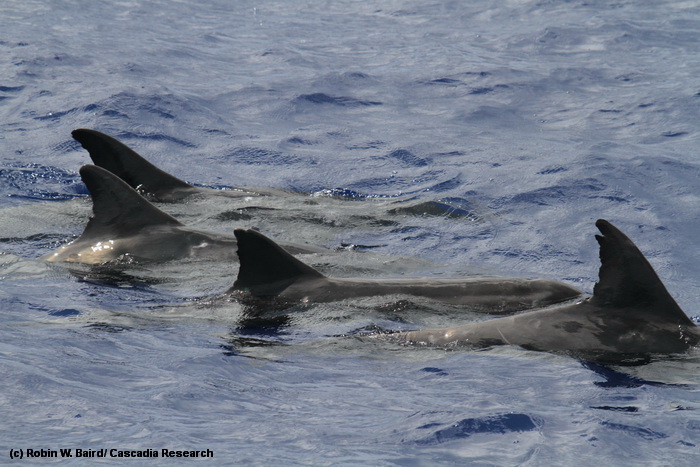
Four distinctive rough-toothed dolphins, May 13, 2011. Photo by Robin Baird. We use both the notches on the trailing edge of the dorsal fin, and the pigmentation patterns (most visible on the right-most individual) to identify individuals among sightings. For more information on rough-toothed dolphins in Hawai‘i see our web page for that species.
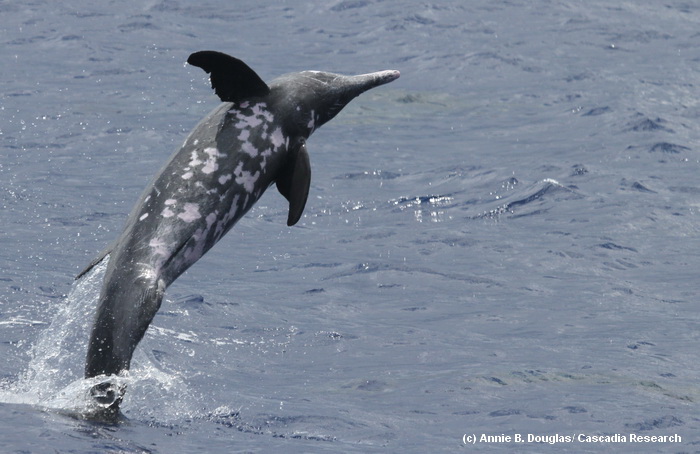
Rough-toothed dolphin leaping, May 13, 2011. Photo by Annie Douglas. Note the large pectoral flippers – rough-toothed dolphins have among the largest pectoral flippers relative to body size of any odontocete. All the white scars on the belly of this individual are from cookie-cutter shark bites. This is an adult male, with a very enlarged post-anal keel.
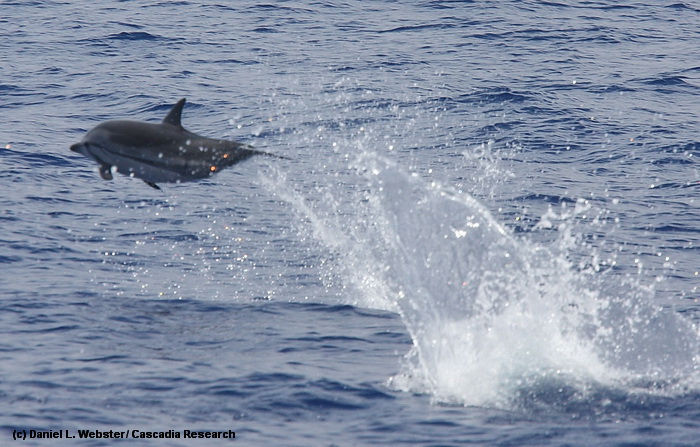
Leaping striped dolphin, May 13, 2011. Photo by Daniel Webster. We also encountered a small group of striped dolphins in about 3,500 meters of water. Striped dolphins are seen fairly regularly in deep (>3,000 m) water offshore of the islands, although they typically avoid boats.For more information on striped dolphins in Hawai‘i see our web page for that species.
May 12, 2011 update
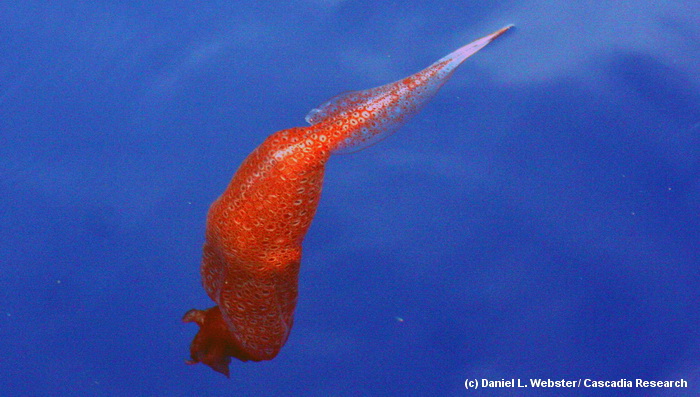
Today we collected our third and fourth squid for the trip – this one was particularly unusual. Photo by Daniel Webster.
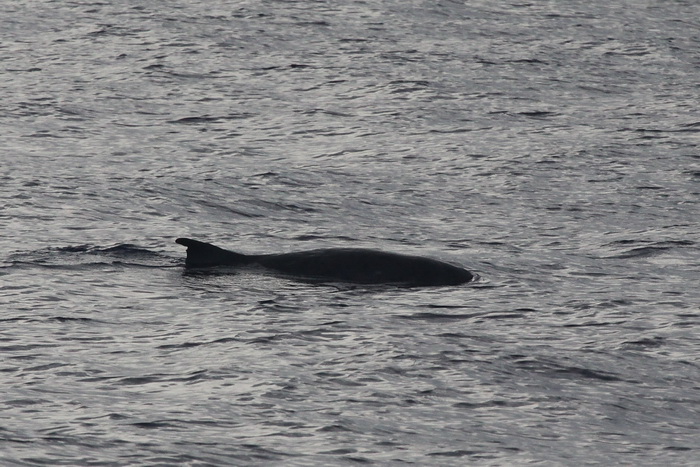
We encountered two groups of dwarf sperm whales, our fifth species for the trip, and were able to obtain identification photos of three different well-marked individuals. Photo by Jessica Aschettino.
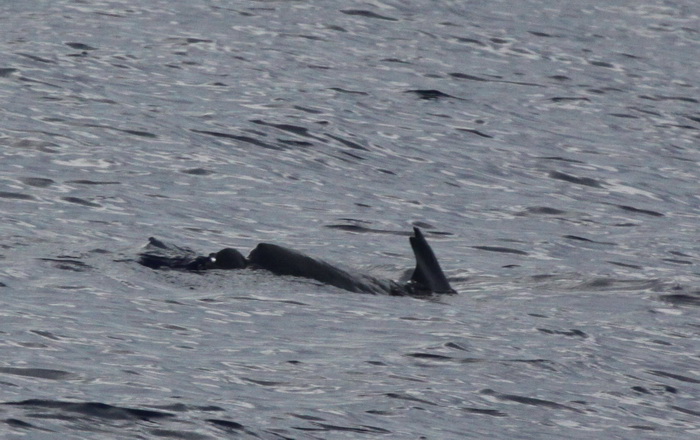
One of the dwarf sperm whales had a deep cut in the peduncle, possibly caused by a line injury. Photo by Jessica Aschettino. For more information on dwarf sperm whales in Hawai‘i see our web page for that species.
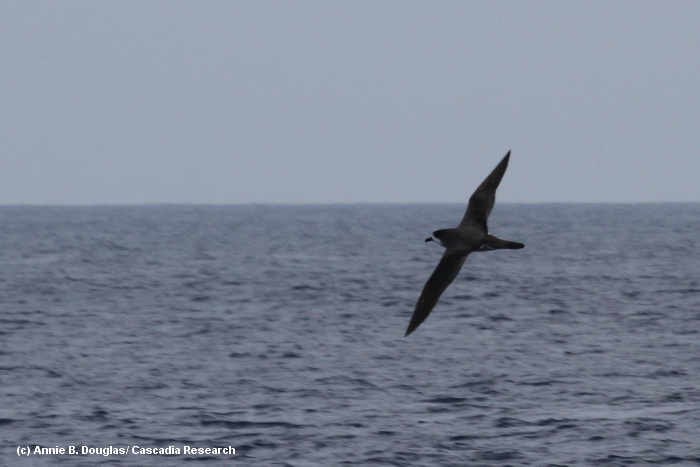
We also had several sightings of Hawaiian petrels today. Photo by Annie Douglas.
May 11, 2011 update
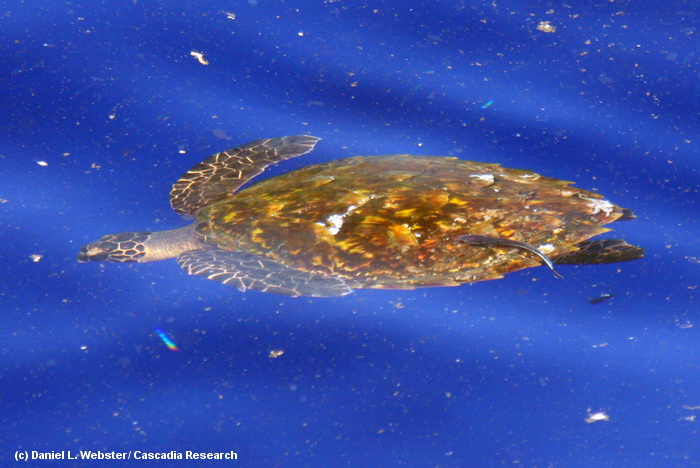
Hawksbill turtle, May 11, 2011. Photo by Daniel Webster. In all of our surveys in Hawai‘i we’ve only documented a sea turtle offshore on one prior occasion (a leatherback turtle seen April 27, 2008). Today we spotted a juvenile Hawksbill turtle 12.5 kilometers offshore in approximately 2,400 meters of water.
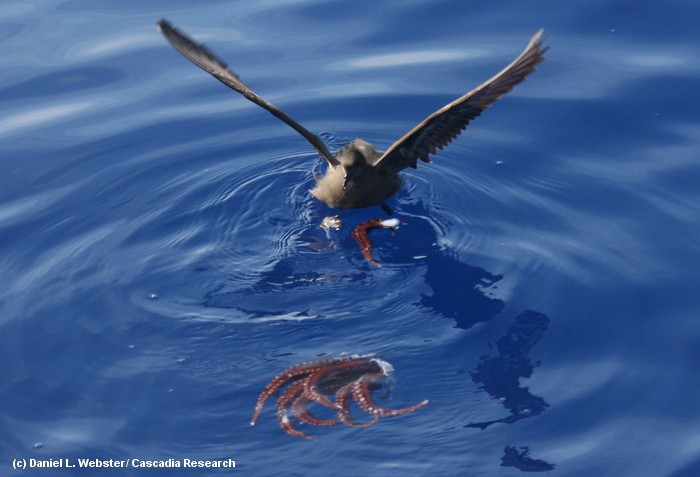
Bulwer’s petrel and squid, May 11, 2011. Photo by Daniel Webster. We also collected our third squid for the trip.
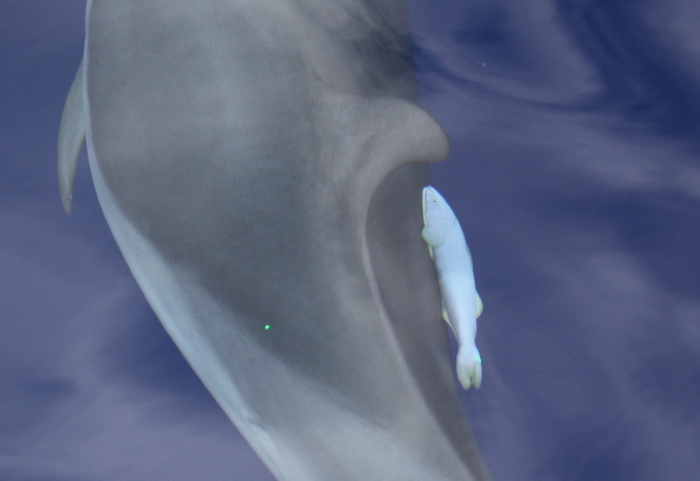
Remora on pantropical spotted dolphin, May 11, 2011. Photo by Jessica Aschettino
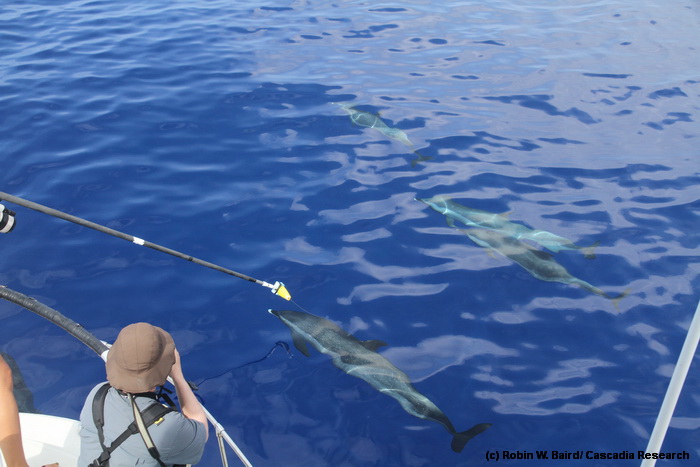
Attempting to deploy a suction-cup attached acoustic/dive tag on a pantropical spotted dolphin, May 11, 2011. Photo by Robin Baird
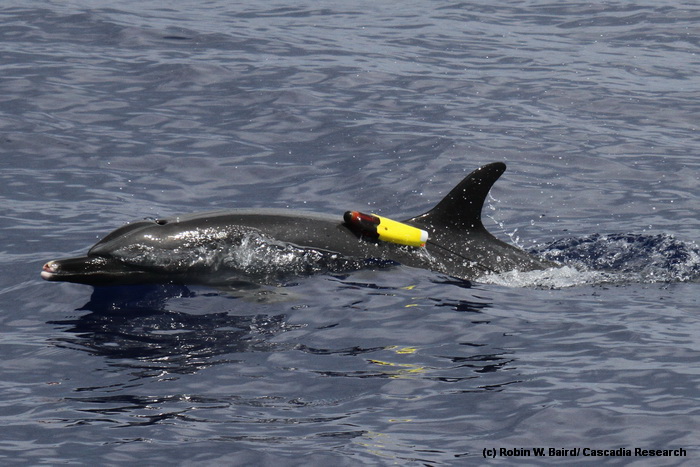
Suction-cup attached acoustic/dive tag on a pantropical spotted dolphin, May 11, 2011. Photo by Robin Baird. The tag was deployed this morning and was still on the dolphin early this evening. We are hoping to recover the tag tomorrow.
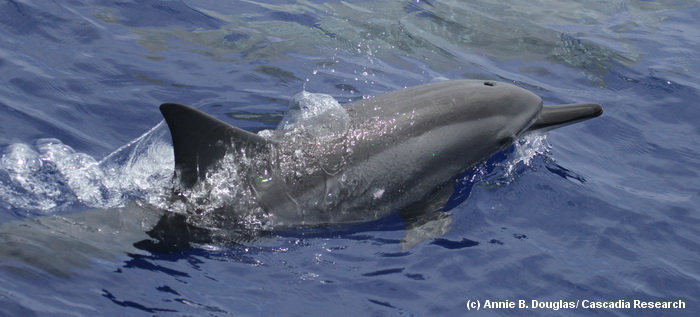
Spinner dolphin, May 11, 2011. Photo by Annie Douglas. We see spinner dolphins regularly at the mouth of the harbor each morning and afternoon as we leave/return, as the harbor mouth is a resting area for spinners. The deepest we’ve ever documented spinner dolphins off the island prior to today was 815 meters – today we encountered two spinner dolphins with the group of spotted dolphins in about 3,000 m water depth, 17 kilometers from shore.
May 10, 2011 update
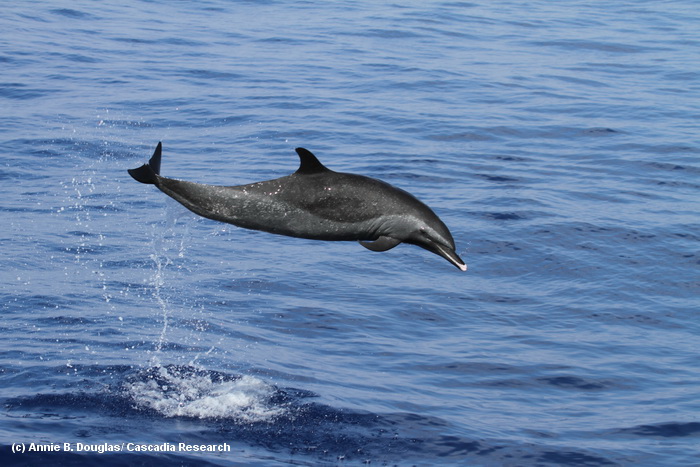
Pantropical spotted dolphin leaping, May 10, 2011. Photo by Annie Douglas.
Today we encountered two groups of spotted dolphins and one unidentified medium-sized odontocete (probably a beaked whale, seen only briefly as it was diving), collected another squid, and re-deployed the HARP.
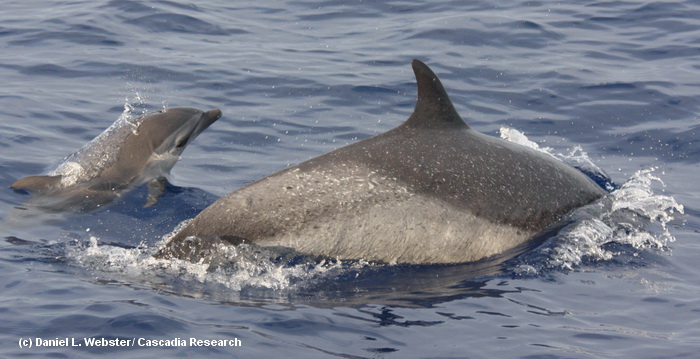
Pantropical spotted dolphin mother and calf, May 10, 2011. Photo by Daniel Webster.
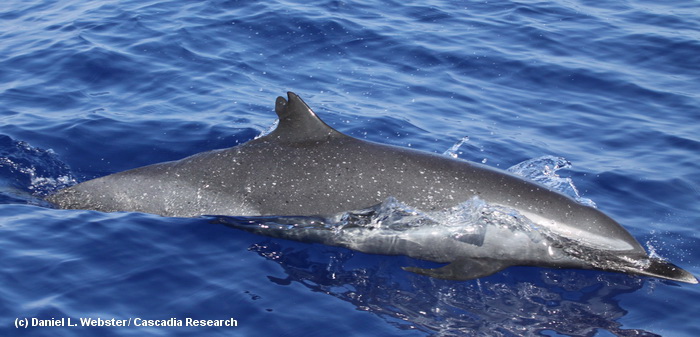
Pantropical spotted dolphin with distinctive dorsal fin, May 10, 2011. Photo by Daniel Webster.
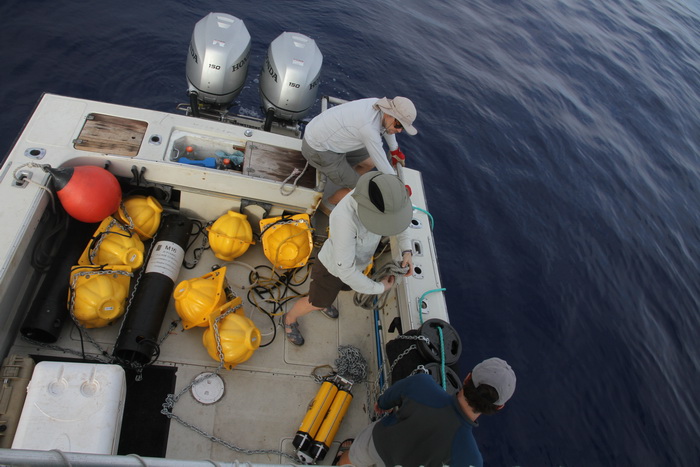
Getting ready to deploy the HARP. This is the 11th deployment of this HARP off the Kona coast in the last five years. Photo by Robin Baird. The HARP includes two acoustic release mechanisms (in the bottom right of the photo), the battery case (far left long black tube), the hard drive case (the middle left long black case), seven (yellow) floats, the hydrophone (not visible), and 300 lbs of weights.
May 9, 2011 update
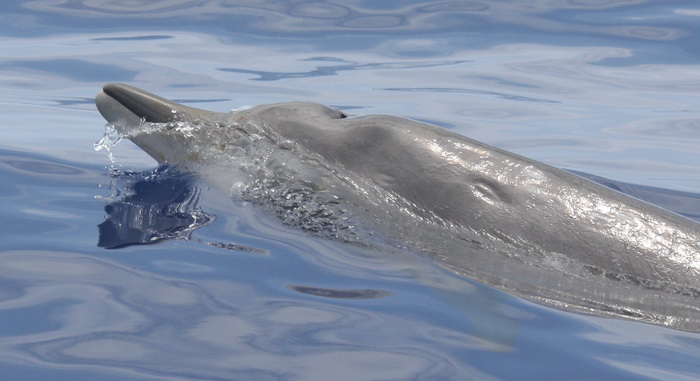
Juvenile Blainville’s beaked whale off Kona, May 9, 2011. Photo by Erin Oleson.
Our fourth day on the water and we encountered our fourth species of cetacean for the trip, a group of three Blainville’s beaked whales. We were able to photo-identify all three individuals and will compare them to our catalog – there is a resident population of Blainville’s beaked whales off the island (see our web page on beaked whales for more infomation on this species.
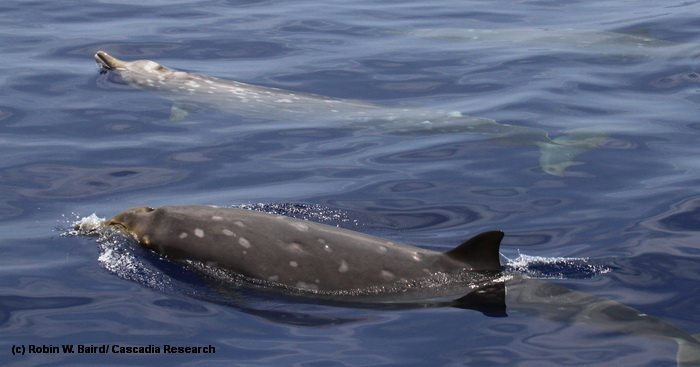
Adult female (in back) and sub-adult Blainville’s beaked whale, May 9, 2011. Photo by Robin Baird. The white oval scars on the sides of these individuals are scars from cookie-cutter sharks – these scars are visible for up to at least 9 years and the unique configuation of the scars are the primary marks we use to identify individuals.
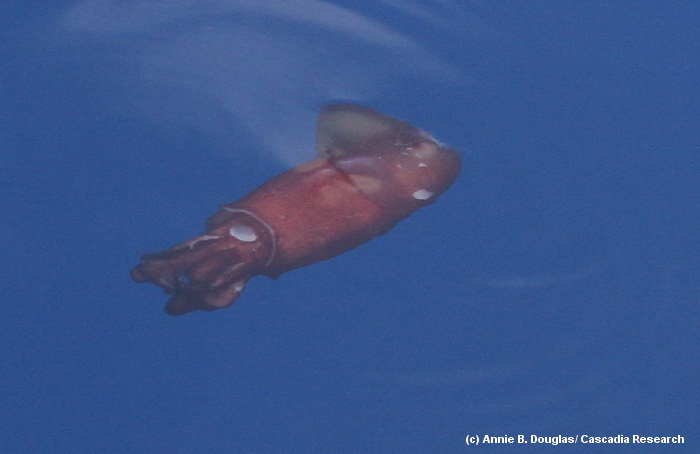
Squid floating off Kona, May 9, 2011. Photo by Annie Douglas. We were also able to collect a squid sample today, which will be used to determine which species of squid are available as prey for different species of toothed whales in the area.
May 8, 2011 update
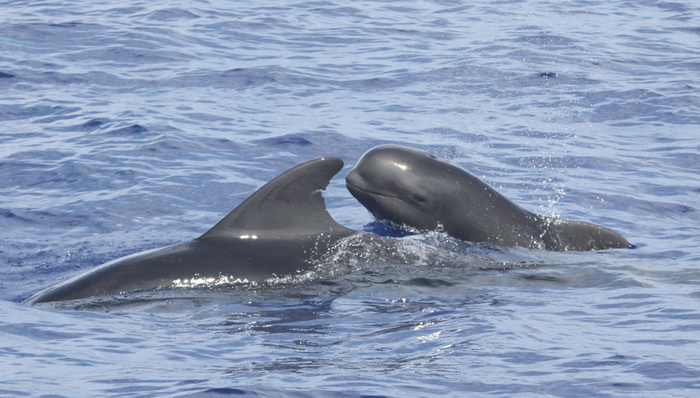
Short-finned pilot whale mother and calf, May 8, 2011. Photo by Jessica Aschettino
Today we covered 173 kilometers off the west side of the island of Hawai‘i. Although conditions ranged up to Beaufort 4, most of the day was spent in good sighting conditions. Despite covering such a broad area and the good sighting conditions, we covered 162 kilometers before our first (and only) sighting of the day, a group of about 20 short-finned pilot whales.
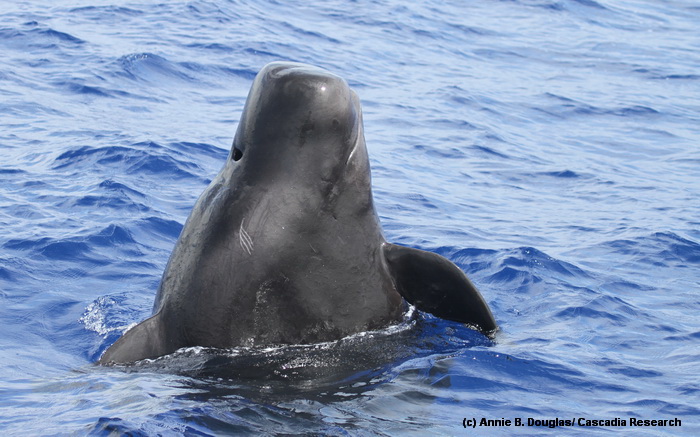
Adult male short-finned pilot whale spyhopping, May 7, 2011. Photo by Annie Douglas. This individual has extremely well-developed muscle masses on the back, obviously a very robust male.
May 7, 2011 update
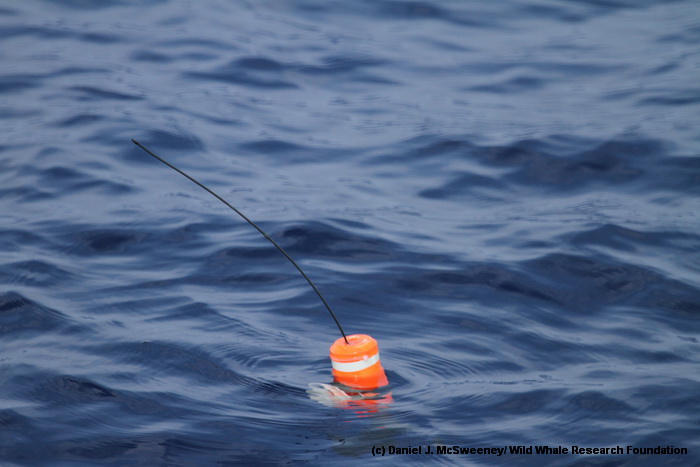
Floating Acousonde tag, May 7, 2011, photo by Dan McSweeney.
Our primary goal for the day was to recover the Acousonde deployed on a pilot whale. One person stayed on land to get bearings using the VHF signal, and we headed out of the harbor, eventually recovering the tag about 45 kilometers south of the harbor.
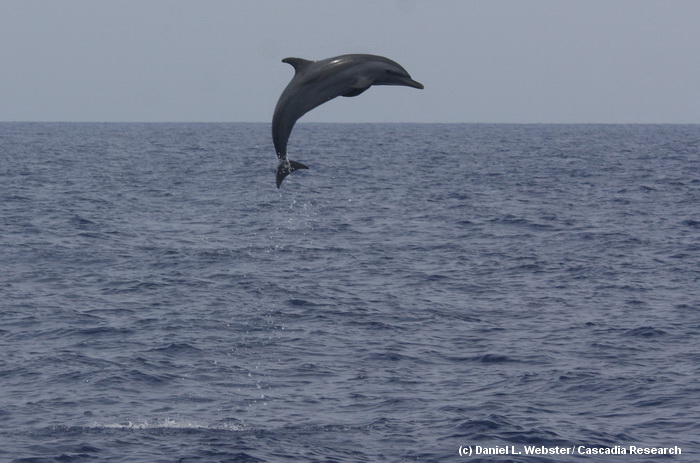
Leaping juvenile pantropical spotted dolphin, May 7, 2011, photo by Daniel Webster.
After the tag recovery we continued searching with the hopes of finding another group of pilot whales to deploy a second tag. Although we did not find any pilot whales we did see a group of about 160 pantropical spotted dolphins.
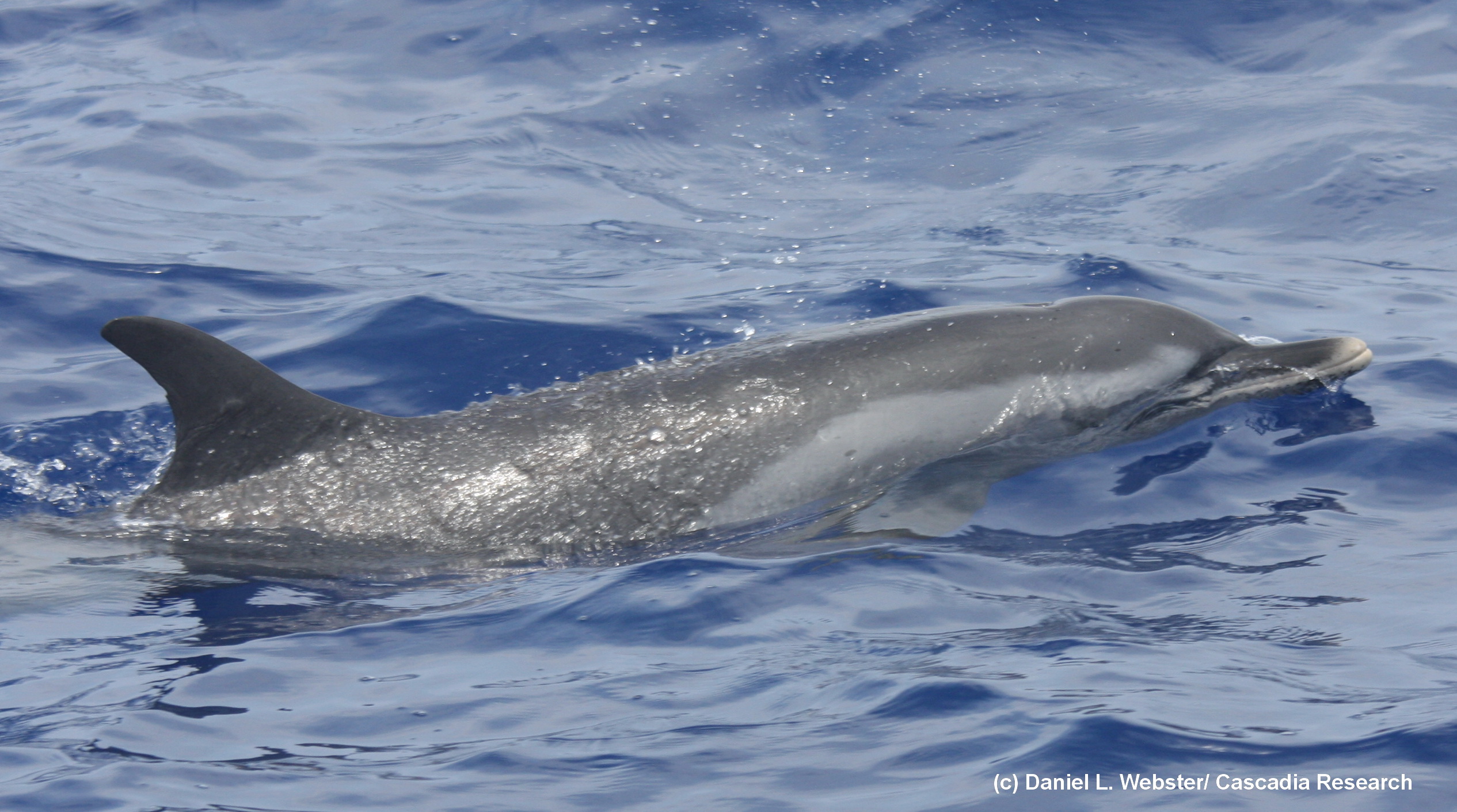
Pantropical spotted dolphin, May 7, 2011, photo by Daniel Webster.
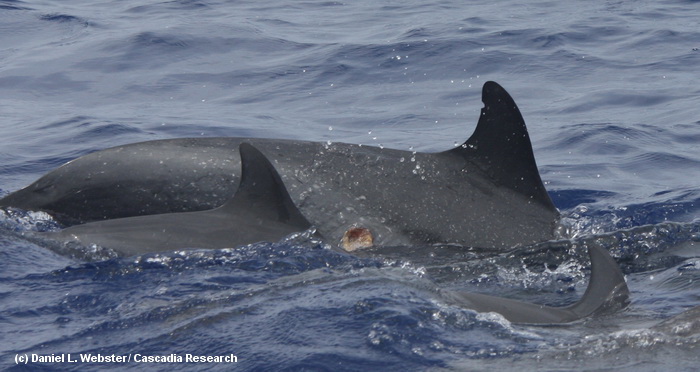
Pantropical spotted dolphins, May 7, 2011, photo by Daniel Webster. The largest individual in the middle, probably an adult female, has a relatively fresh bite wound from a cookie-cutter shark.
May 6, 2011 update
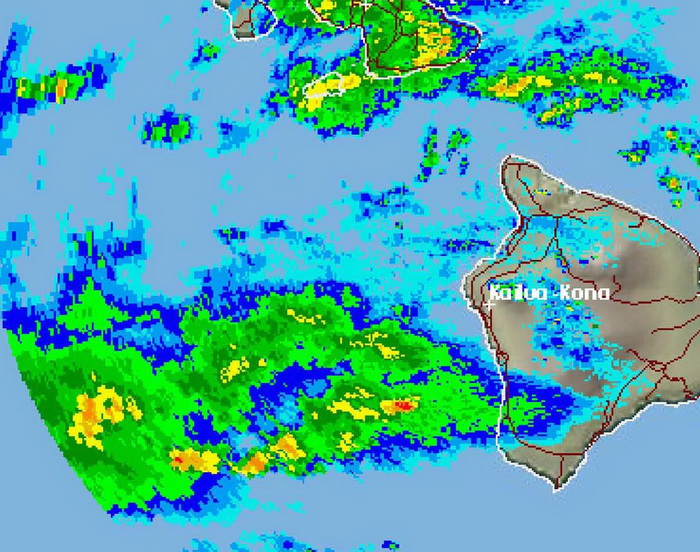
We had a delayed start to the day due to a large storm cell off the southern part of the Kona coast, but still had a productive day.
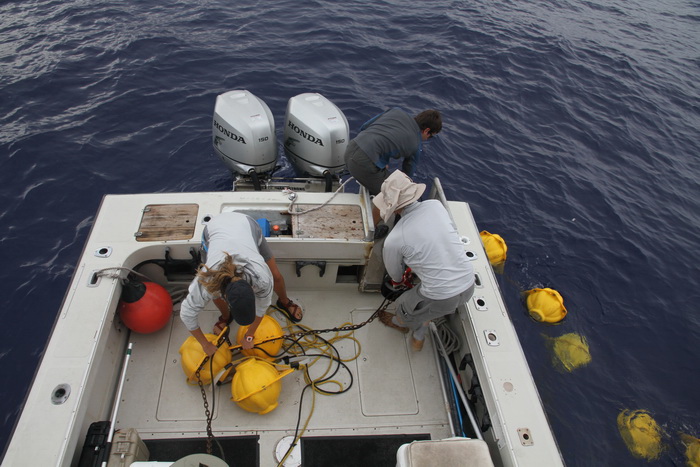
Recovering the HARP, May 6, 2011. Photo by Robin Baird.
Early in the day we recovered a HARP (High-frequency Acoustic Recording Package) deployed by the NMFS Pacific Islands Fisheries Science Center in September 2010. The HARP records sounds up to 100 kHz, and is used to monitor the presence of a number of species of cetaceans off the Kona coast. Tomorrow the hard drives on the HARP will be switched out and the batteries replaced and we hope to re-deploy it early next week. For more information on some of the results from previous deployments of the HARP see a report produced for the Naval Postgraduate School in November 2010.
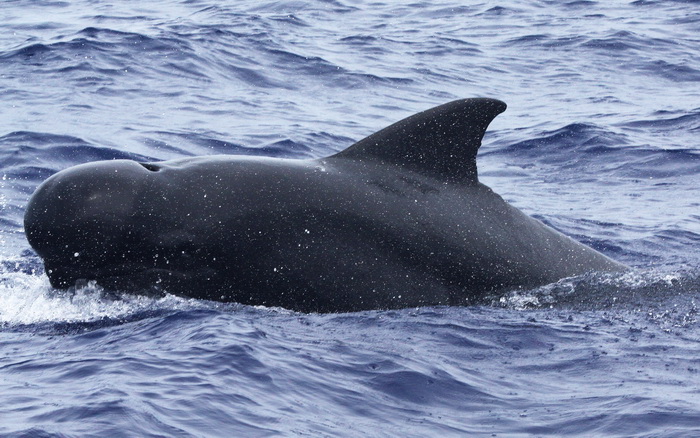
Short-finned pilot whale, May 6, 2011. Photo by Jessica Aschettino
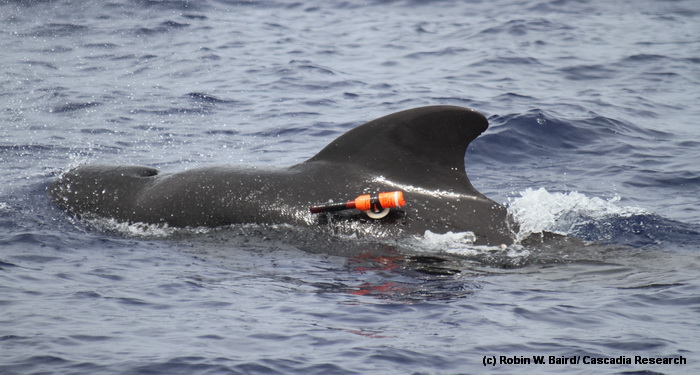
A short-finned pilot whale with a suction-cup attached “Acousonde” tag, May 6, 2011. Photo by Robin Baird.
After recovering the HARP we encountered a large group (~40 individuals) of short-finned pilot whales. We were able to photo-identify all the individuals present, and deployed a suction-cup attached acoustic-dive tag, an Acousonde. The tag is recording sounds produced by the tagged whale and others nearby, as well as information on the whale’s depth and orientation. The tag remained on throughout the day and we are hoping to recover it tomorrow.
Sign up to our Facebook page if you want to receive notices of when information is posted and updates on other Cascadia projects.
For more information see our Hawai‘i odontocete research page